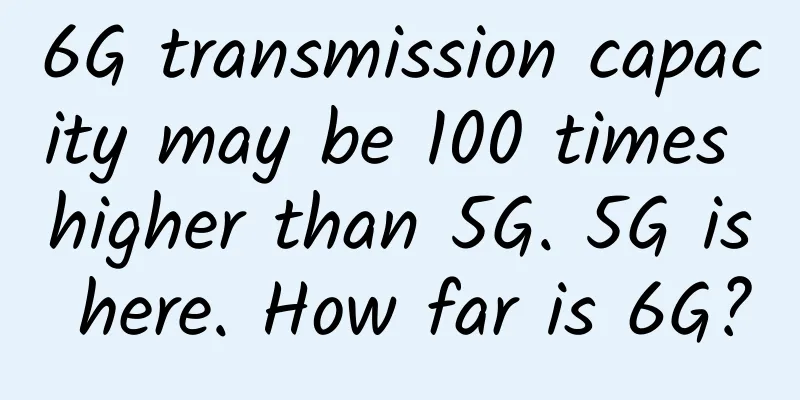6G transmission capacity may be 100 times higher than 5G. 5G is here. How far is 6G?

|
How long does it take to download a 1G high-definition movie on a mobile phone through the fastest 5G mobile network? The answer is about 3 seconds, which is 10 times faster than the 4G era. So, what about 6G? "In the 6G era, hundreds of high-definition movies can be downloaded in one second!" Professor Peng Mugen, executive director of the China Communications Society and executive dean of the School of Information and Communication Engineering of Beijing University of Posts and Telecommunications, told reporters that 6G's transmission capacity may be 100 times higher than 5G, and the theoretical network speed can reach 1TB per second. Network delay can also be reduced from milliseconds to microseconds. "In addition to being faster, 6G networks will also enable interoperability between ground and satellite communication networks, and applications will be smarter." Professor Qiao Jianyong, vice president of the China Communications Society and president of Beijing University of Posts and Telecommunications, told reporters that 6G technology is a disruptive innovative technology that integrates communication, perception, and computing; with the large-scale commercial use of 5G mobile communication technology, China, the United States, Germany, Japan, South Korea and many other countries have launched research and exploration of 6G communication technology. At present, my country's 6G technology research and development is at the forefront of the world, and large-scale trials and typical application demonstrations may be carried out as early as the end of 2024. 6G is a high-speed intelligent network that can achieve global coverageWhy develop 6G technology? "It is difficult for 5G to cover all land, and land only accounts for 29% of the earth, so 5G networks need to be supplemented by 6G satellite communications. 6G technology integrates terrestrial wireless communication technology with medium, high and low orbit satellite mobile communication technology and short-distance direct communication technology to solve communication, computing, navigation, perception and other problems, and to build a mobile communication network covering the air, space, land and sea, and realize a high-speed intelligent network covering the world." Li Deren, an academician of the Chinese Academy of Sciences and the Chinese Academy of Engineering, said that in the future, 6G can achieve full global coverage and realize satellite communication intelligent services of "one satellite for multiple uses", "multi-satellite networking" and "multi-network integration".
Qiao Jianyong introduced that 6G will be an omnipresent communication network, and the communication network will evolve towards a native intelligent network. The traditional network architecture for personal communication will no longer be applicable, and the architecture integrating communication, perception, and computing needs to be redesigned. The application scenarios include the Internet of Things, drone networks, satellite communication networks, dense cellular networks, and many other forms. "From 1G to 5G, previous communication technologies were mostly centered on base stations and network equipment, while 6G will break through the single dimension of traditional communications and carry out deep integration of communication, computing, perception, and energy to better meet the needs of future smart applications." Qiao Jianyong said that in recent years, emerging smart applications such as smart transportation, drones, metaverse, immersive extended augmented/virtual reality (XR), and high-precision industrial Internet have continued to evolve and develop. 5G networks can no longer efficiently support many smart applications, so scientists are now vigorously developing 6G networks. 6G will play a big role in areas such as autonomous driving and the metaversePeng Mugen introduced that 6G has a wide range of applications and can solve bottleneck problems in many current fields, such as autonomous driving. "Currently, the perception capabilities of smart cars mainly rely on a variety of local sensors, including cameras, millimeter-wave radars, GPS, lidar, etc. Although the comprehensive accuracy reaches the centimeter level or even the millimeter level, it still cannot meet the needs of autonomous driving because of the limited perception range and insufficient perception accuracy, and the ability to respond to emergencies is insufficient." Peng Mugen said that in the future, the 6G network will be able to successfully solve the current bottleneck problems that restrict the development of unmanned driving and smart vehicle networks. "The metaverse, which is very popular now, also needs the support of 6G technology." Peng Mugen said that the perception of the virtual world now mainly relies on cameras, photodiodes, time-of-flight sensors, inertial sensors and handles, and display devices rely on head-mounted displays or holographic glasses. The experience is far from deep immersion. In the future, 6G will be able to provide the metaverse with real-time interaction, huge capacity, full-factor perception, etc., allowing users to be "immersive". Qiao Jianyong introduced that at the beginning of 2019, Beijing University of Posts and Telecommunications gathered researchers from multiple disciplines such as information and communication engineering, systems science, mathematics, physics, materials, and biology to form a number of 6G-oriented research and development teams. Driven by practical applications and driven by basic theoretical breakthroughs, they launched scientific research in multiple areas. my country's 6G large-scale trials may occur as early as 2024From 5G to 6G, what are the current technical challenges? Qiao Jianyong introduced that 6G is a complex intelligent network system. The challenges faced by the current technical system include at least high dynamic changes in transmission links, complex network spatiotemporal behaviors, and integrated networking of air, land, and sea. Some disruptive materials and technological breakthroughs are urgently needed. Qiao Jianyong said that because 6G networks are faster and smarter, the information transmitted, the equipment used, the communication process, etc. are all very complex. The basic theory should focus on the integration of systems theory, information theory, cybernetics, and game theory. Intelligent networks that integrate communication, computing, and perception, as well as the construction of integrated networks in the air, land, and sea, all require disruptive innovations in information theory and practice. In other words, 6G technology needs to achieve a subversion of basic theory, system architecture, and key technologies. Qiao Jianyong introduced that 6G, as the inevitable evolution direction of 5G, needs to establish an intelligent and efficient communication network for human-machine-object interconnection, realize integrated multi-dimensional data collaborative processing, and improve perception accuracy and distance. These are the global commanding heights of future information communication theory and technology. Although the large-scale commercialization of 6G is planned to be realized around 2030 internationally, in view of my country's emphasis on 6G and its scientific and technological innovation capabilities, 6G large-scale trials and typical application demonstrations may be carried out as early as the end of 2024. "After 6G is commercialized, it will bring more intelligent applications, and the market size will far exceed 5G, which will help implement my country's new infrastructure, digital industrialization, and industrial digitalization strategies." Peng Mugen said that 6G can not only bring users a more immersive and ultimate experience, meet the needs of human communication and interconnection at multiple sensory, emotional and conscious levels, but also can be widely used in entertainment life, medical health, industrial production and other fields, to help my country's various industries in digital transformation and upgrading, and meet the various application needs of the future smart society. |
<<: 6G network, what application scenarios will it have in the future?
>>: Serverless Engineering Practice | Quickly Build Kubeless Platform
Recommend
Why is HTTPS protocol secure?
1. What is HTTPS protocol security? As we all kno...
Five ways to establish effective communication in remote teams
The term "remote" itself has a connotat...
How to deal with the impact of digital transformation on the network?
Digital transformation has increased the importan...
What are the challenges of using multiple team collaboration apps?
Many companies are already using various team col...
Exclusive interview with Li Xiaodong from DYXnet: Using SASE to strengthen network boundaries and provide “cloud-edge-device” security empowerment
In today's digital age, the stability and sec...
Huawei's Intelligent IP Network Solution Creates a Simplified 5G Bearer Network
At the HAS Analyst Conference recently, Chen Jinz...
F5 and Zhiwei Data jointly launched an active application quality measurement solution to help enterprises gain real-time insights into business status
Recently, F5, the world's leading multi-cloud...
[11.11]RAKsmart: US servers start from $30/month, Japan/Korea servers start from $59/month, cluster servers start from $109/month
A few days ago, we shared RAKsmart's recharge...
Writing crawlers has become "prison programming" because you don't understand the Robots protocol
[[386960]] It is easy to write Python crawlers, b...
Come and watch! The Maker Beijing 2020 Kunpeng Application Innovation Special Competition Seminar is about to start!
In order to help more ICT industry practitioners ...
H3C wins bid for Qingdao Metro to boost the development of Qingdao's urban rail transit
Recently, New H3C Group, a subsidiary of Tsinghua...
RackNerd Spring Festival Promotion: KVM annual payment starts at $13.99, 1.5GB/20GB/3TB/multiple computer rooms
RackNerd is a foreign VPS hosting company founded...
GraphQL vs. REST: What have you learned?
Overview When creating a web service application,...
5 Things That Can Slow Down Your Wi-Fi Network
Wi-Fi networks can be slow due to the use of olde...
Hostodo: $19.99/year KVM-1GB/12GB/4TB/Las Vegas
Hostodo has released several promotional packages...









